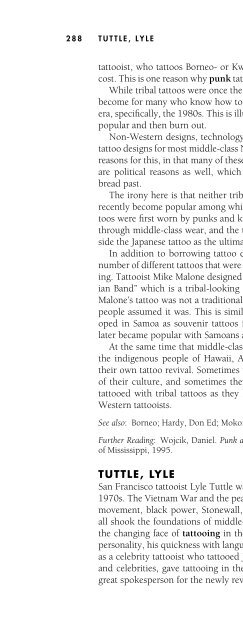Encylopedia of Body Adornment.pdf - Print My Tattoo
Encylopedia of Body Adornment.pdf - Print My Tattoo
Encylopedia of Body Adornment.pdf - Print My Tattoo
You also want an ePaper? Increase the reach of your titles
YUMPU automatically turns print PDFs into web optimized ePapers that Google loves.
288 TUTTLE, LYLE<br />
tattooist, who tattoos Borneo- or Kwakiutl-inspired designs on his friends for no<br />
cost. This is one reason why punk tattoos are so heavily weighted toward tribalism.<br />
While tribal tattoos were once the ultimate elite, non-Western tattoo, they have<br />
become for many who know how to read such tattoos, simply a relic <strong>of</strong> an earlier<br />
era, specifically, the 1980s. This is illustrative <strong>of</strong> how quickly tattoo trends become<br />
popular and then burn out.<br />
Non-Western designs, technology, and styles have firmly uprooted traditional<br />
tattoo designs for most middle-class North Americans. There certainly are aesthetic<br />
reasons for this, in that many <strong>of</strong> these designs simply make good tattoos, but there<br />
are political reasons as well, which involve repudiating a working-class, whitebread<br />
past.<br />
The irony here is that neither tribal tattoos, nor the Chicano tattoos that have<br />
recently become popular among whites, originated in the middle class—tribal tattoos<br />
were first worn by punks and kinky gays. Yet they have become popularized<br />
through middle-class wear, and the tribal tattoo, at least for a while, stood alongside<br />
the Japanese tattoo as the ultimate middle-class tattoo.<br />
In addition to borrowing tattoo designs from other cultures, there are now a<br />
number <strong>of</strong> different tattoos that were created to look like non-Western, tribal tattooing.<br />
<strong>Tattoo</strong>ist Mike Malone designed a tattoo style in the 1970s called the “Hawaiian<br />
Band” which is a tribal-looking design made to wrap around an arm. While<br />
Malone’s tattoo was not a traditional design, it looked enough like one that many<br />
people assumed it was. This is similar to the “Peace Corps tattoos” which developed<br />
in Samoa as souvenir tattoos for white Peace Corps volunteers but which<br />
later became popular with Samoans as well.<br />
At the same time that middle-class North Americans are wearing tribal tattoos,<br />
the indigenous people <strong>of</strong> Hawaii, Australia, and New Zealand are experiencing<br />
their own tattoo revival. Sometimes the tattoos that they wear are in the tradition<br />
<strong>of</strong> their culture, and sometimes they are Western images. Quite <strong>of</strong>ten, they are<br />
tattooed with tribal tattoos as they have been recreated in the United States by<br />
Western tattooists.<br />
See also: Borneo; Hardy, Don Ed; Moko; Punk; Samoa; <strong>Tattoo</strong>Time; Zulueta, Leo<br />
Further Reading: Wojcik, Daniel. Punk and Neo-Tribal <strong>Body</strong> Art. Jackson: University Press<br />
<strong>of</strong> Mississippi, 1995.<br />
TUTTLE, LYLE<br />
San Francisco tattooist Lyle Tuttle was one <strong>of</strong> the most influential tattooists <strong>of</strong> the<br />
1970s. The Vietnam War and the peace movement that it spawned, the civil rights<br />
movement, black power, Stonewall, and the new women’s liberation movement<br />
all shook the foundations <strong>of</strong> middle-class stability, and all contributed as well to<br />
the changing face <strong>of</strong> tattooing in the United States. Tuttle, thanks to his vibrant<br />
personality, his quickness with language, his shop in San Francisco, and his status<br />
as a celebrity tattooist who tattooed Janis Joplin and a number <strong>of</strong> other rock stars<br />
and celebrities, gave tattooing in the 1970s a very public face. Tuttle was also a<br />
great spokesperson for the newly reviving art <strong>of</strong> tattooing because many tattooists



